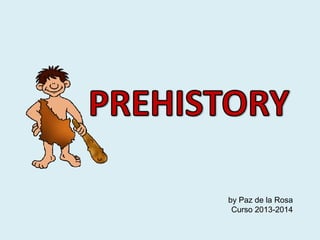
Prehistory
- 1. by Paz de la Rosa Curso 2013-2014
- 2. Prehistory the period of time in the past before people could write
- 3. Prehistory starts with the appearance of the first hominid, 4.5 million years ago, and finishes with the invention of the writing, 3,500 years b.C. This long period can be divided into 3 stages: - Paleolithic Age - Neolithic Age - Metal Age
- 5. PALEOLITHIC PALEOLITHIC means “old stone”. It starts with the appeareance of the first hominids (4.5 million of years ago) and ends with the discovery of agriculture (7,000 years b.C.)
- 6. During that time, humans got their food by hunting animals, by fishing and by gathering fruits, nuts, and other wild plant . They were nomadic, they travel from time to time or with the seasons to find food and following the animals.
- 7. They form small groups of 20 or 30 people called tribes. The members of a tribe belong to the same family. They live up to about 35 years because of a cold climate and common diseases.
- 8. They live in caves or huts made with sticks and the skin of the animals
- 10. TOOLS Men discovered that by hitting rocks together, they could make tools. Tools were so important that the material they were made of is used to refer to different ages of human history—the Stone Age, the Bronze Age, the Iron Age, etc…
- 12. FIRE Life changed a lot for the early humans when they discovered how to make fire. The fire allowed them to cook food, warm themselves and have light. Fire could also be used to cut down trees and protect against wild animals.
- 13. ART Around 30,000 years ago humans begin painting on the walls of caves. This shows an artistic sensibility.
- 14. Characteristic of the art They paint animals: horses, deers, bisons, mammoth, etc. Colours: brown, black, red and yellow made from natural materials. Animal hair is used to make brushes. They believe that painting give good luck in hunting
- 15. NEOLITHIC The Neolithic Era (New Stone Age) begins 10,000 years ago, when humans invented agriculture and livestock raising. Neolithic people learn how to plant cereals and to farm and domesticate animals.
- 16. Neolithic people are not nomadic. They settle down in towns and build houses because they have to farm and need to be close to their fields.
- 17. They begin to form villages around the fields they farm and they learn how to make many new things like: jewelry, pottery, bigger houses, better clothing, and stronger tools.
- 18. Once people begin building houses and living in towns life got easier. They divide up the work; some people farm, some take care of animals, some build houses, some make tools, some make clothing, some made pottery, etc.
- 19. Trade begins during the Neolithic Era. Trade is buying and selling/exchanging goods. During the Neolithic people begin to trade for things they want, so some people become traders.
- 20. TOOLS People use stone tools, but they begin to be more sophisticated, specialized, and they are often polished to a fine finish. Pottery is made for the first time during the Neolithic Age. These pots are very simple.
- 21. ART The human figure becomes important in Neolithic art, which often paints scenes with groups of people hunting, farming or dancing. Figures in these paintings were very schematic.
- 23. METAL AGE • The Age of Metals began when human beings to learn how to use metals to make objects (5.000 years BC). • First they use copper, then bronze and finally iron.
- 24. TOOLS AND TECHNOLOGY Metal tools are better than stone tools. They are stronger and can be sharpened. Metal is used for: -Tools such as ploughs and knives -Weapons such as swords. -Jewlery such as necklace. plough weapons jewlery
- 25. FIRST CITIES • Agriculture, livestock and the new technical advances, improve peoples lives. Because of this, population increased. Some villages become small cities with hundreds of inhabitants. • Cities are surrounded by walls, and inside there are buildings with different functions: houses, stores, shops or workshops. • First cities houses are small, their walls are made of adobe or stone and their ceilings were made of straw.
- 27. MEGALITHIC MONUMENTS In the late Neolithic Age, human beings built what we can call the first monuments using big blocks of stone, called megaliths (big stones). The main monuments are menhirs, dolmens and cromlechs (stone circles).
- 28. MENHIRS Menhirs are big, long stones vertically put into the ground. Menhirs are probably religious constructions dedicated to worship the sun.
- 29. DOLMENS Dolmens are collective burial places. They are made of big, long vertical stones covered by several horizontal slabs of a great size.
- 30. CROMLENCH Cromlechs are wide circles formed by several menhirs put in round. They were probably used as sanctuaries